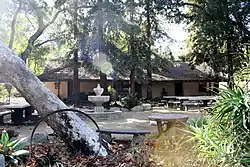Catalina Verdugo Adobe | |
 | |
| Location | 2211 Bonita Dr. Glendale, California |
|---|---|
| Coordinates | 34°10′48″N 118°13′56″W / 34.18000°N 118.23222°W |
| Built | 1828–1830s |
| Architectural style | Adobe |
| NRHP reference No. | 76000487 |
| CHISL No. | 637 |
| Added to NRHP | December 12, 1975 |
The Catalina Verdugo Adobe, also known as the Catalina Adobe, the Verdugo Adobe, and the Teodoro Adobe, is a historic adobe building and a public park located at 2211 Bonita Drive in Glendale, California.
History
The adobe was built on a small portion of the Rancho San Rafael which was granted to José María Verdugo in 1784. Jose Maria Verdugo's grandson, Teodoro Verdugo, built the adobe on a small portion of the rancho.[1][2] Some sources indicate that the adobe was built for José María Verdugo's blind daughter, Catalina, who lived there until her death in 1871.[1]
The most probable date of construction was between 1828 and the 1830s, which are claimed by the City of Glendale and California Parks Service, respectively.[3][4]
Other sources indicate that Catalina lived in the adobe with Teodoro and his family up until her passing in 1861.[5][6]
Preservation
The adobe was designated as the first entry on the Glendale Register of Historic Resources.[7] It was also registered in 1958 as California Historical Landmark No. 637.[8] In 1976, the adobe along with the nearby "Oak of Peace" were listed on the National Register of Historic Places.[9] The property is now owned by the City of Glendale and is operated as a historic park.[10][11]
Markers
Markers on the site read:[12]
- Marker at entrance: San Rafael Ranch - Jose Maria Verdugo granted land use by Gov. Pedro Fages, 1784 Deed recorded, 1799. State Historic Landmark No. 637. National Register of Historical Places – 1976
- Marker at entrance: Oak of Peace - Site of pre-surrender conference between the Mexican settlers and a representative of the invading American forces on January 11, 1847. Jesus Pico, acting as an emissary from Lt. Col. Fremont, met under the oak with General Andres Pico and Governor Flores of the Californios to urge the signing of the treaty.
- San Rafael Rancho First granted to José Maria Verdugo, Oct. 20, 1784 Catalina Adobe built about 1828 and General Andres Pico oak tree camp site before he surrendered to John C. Fremont 1847 Marked by California Parlor No. 247 Native Daughters of the Golden West Sept. 28, 1947
- 637 Catalina (Verdugo) Adobe San Rafael Rancho of Jose Maria Verdugo Built about 1828 Placed by Don Jose Verdugo Chapter Daughters of the American Revolution 1958
See also
References
- 1 2 "History of The Catalina Verdugo Adobe". MyGlendale. Retrieved July 8, 2019.
- ↑ "Adobes of Glendale: The Verdugo Heritage". MyGlendale. Retrieved July 8, 2019.
- ↑ "Catalina Verdugo Adobe | City of Glendale, CA". www.glendaleca.gov. Retrieved 2022-04-18.
- ↑ "CHL # 637 Catalina Adobe Los Angeles". www.californiahistoricallandmarks.com. Retrieved 2022-04-19.
- ↑ Martha L. Willman (October 28, 1984). "Date Debate Still Surrounds Historic Verdugo Adobe". Los Angeles Times. p. IX-3 – via Newspapers.com.
- ↑ Clarence Cullimore (April 22, 1945). "The Two Verdugo Adobes". Los Angeles Times. p. Home magazine, p. 3 – via Newspapers.com.
- ↑ "Glendale Register of Historic Resources". City of Glendale. December 2015. Retrieved July 8, 2019.
- ↑ "Catalina Adobe". California State Parks, Office of Historic Preservation. Retrieved July 8, 2019.
- ↑ "Entry for San Rafael Rancho (Verdugo Adobe and Oak of Peace". National Park Service. Retrieved July 9, 2019.
- ↑ "Catalina Verdugo Adobe". City of Glendale. Retrieved July 9, 2019.
- ↑ nps.gov, Verdugo Adobe
- ↑ #637 – Catalina Adobe Markers